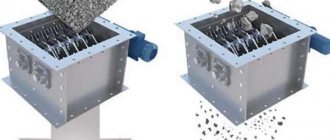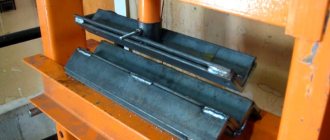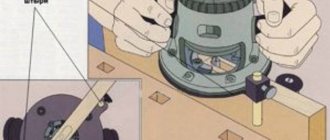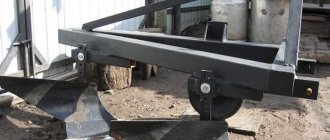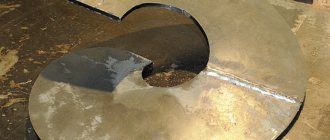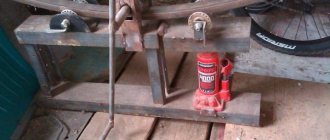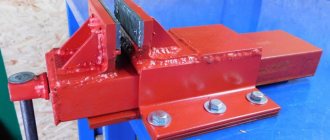Modern juicers cost a lot of money, and besides, they don’t work that well. Therefore, I decided to make a juicer with my own hands, better, simpler and, most importantly, cheaper.
For a homemade juice press you will need:
- 40mm plywood. You can glue several sheets of plywood with special wood glue.
- Good paint for interior surfaces
- Bottle jack, lifting capacity 4 tons
- 10mm threaded stud
- Flange or steel plate for press
- Thermoplastic
- Stainless steel sheet
- Primer spray
- Wood glue.
Required tools:
- Saw. Any will do. Jigsaw, table saw, band saw or regular hand saw.
- Cordless drill.
- Clamps
Additional tools for screw squeezer:
- Countersink
- Grinder
- Threading tools
Simple tips for your safety:
- Keep your hands away from anything that moves
- Wear safety shoes
- Wear safety glasses
What materials will be needed
You will need a tool that is used to process metal and wood, as well as a regular plumbing kit. It all depends on the design of the device and the available workpieces and materials.
Based on the degree of automation, a distinction is made between electrically conductive and manual models.
What you need to prepare:
- saws for processing wood and metal (a grinder with interchangeable wheels is suitable);
- hammer;
- keys according to the diameter of the bolts used;
- pliers;
- wire cutters;
- drill with a set of drills for metal and wood;
- jack;
- welding machine (to work with frame elements).
The following materials will also be required:
- container in the form of a tank (maybe a part from an old washing machine, but only whole, without damage to the inside, chips or rust/mold);
- parquet wooden slats with a total length of approximately 15 m, hand-made boards and bars;
- metal pipes with walls from 3 mm thick;
- metal channel;
- a bench screw with a matching nut;
- threaded rod and valve;
- a metal corner or other material for constructing a frame;
- wood glue;
- bolts with nuts, self-tapping screws;
- metal plate for fastening the slats with bolts;
- metal sheet for organizing the pallet;
- burlap or other natural fabric measuring 1.5 x 1.5 m for filtering pulp in the tank.
IMPORTANT: The vitamins contained in fresh fruits are very easily destroyed by prolonged contact with metal. Therefore, it is best to make apple presses with wooden bodies.
To preserve the taste of the juice, it is not advisable to use bars, slats and boards made of pine or spruce. Essential oils and resins in the composition, as a result of contact with juice, significantly distort it.
Also, pressed boards such as chipboard or OSB are not suitable, since their structure is impregnated with phenol-formaldehyde adhesive, which, along with dust and other particles, can enter the product during squeezing.
The promised wine using a homemade juicer
Below is a recipe for chatterbox made by specialists from a special laboratory for the Special Correspondent program. The process is so exciting that it outshines the description of making a homemade juicer. Bormotukha took the silver medal in Sochi.
If the juice from unsuccessfully rolled up cans has fermented, housewives advise:
- Boil until the taste improves. The method is not very good, the aftertaste of fermentation will remain.
- Take into account for the future, improve the sanitary conditions in the area of the homemade juicer. Throw out the spoiled product.
- Allow the juice to completely ferment. It turns out apple cider vinegar, we use it in cooking as usual. Homemade vinegar turns out to be softer.
- Start making cider according to the recipe.
We suggest that you finally start creating a chatterbox in order to avoid questions about why you painstakingly made a homemade juicer. Not just to compete with Vladimir from Tolyatti? In order for the juice to ferment better, you must find a warm place and add sugar (feed the bacteria). If you made cider, the pulp of the trough will do, since the task is to take the medal, let's continue. In three or four days the next step.
Pour fermented juice from a homemade juicer into a large container. The volume overlap is about two times. Stock up for future use:
- citric acid;
- soda;
- cheap imported dry wine;
- glycerin;
- alcohol.
Using a homemade juicer, add 4 liters of fermented product with 100 grams of pure alcohol and a liter of cheap imported wine. Alcohol will give a degree, wine - a bouquet. After all, we make wine, after all!
Citric acid adds sourness to the juice. One package is enough to make the full 5+ available liters. Two bubbles of glycerin are added to prevent the components from reacting with each other. The contents are poured in, the container is shaken and mixed. A few tablespoons of baking soda are added to prevent further fermentation. Otherwise, the wine (the murmur of a homemade juicer) will simply burst the filled bottles.
The journalists, having placed a beautiful girl, equipped the exhibition stand with a chatterbox, managed to receive a silver medal and numerous positive reviews from visitors to the exhibition.
Think before you make a juicer. Dirt, wasps, unsanitary conditions. Homemade juicers are placed in the garden, on the balcony, the conditions are alien to ideal. Make an effort to strictly maintain cleanliness. Is the desire still there? Let's discuss how to make a homemade juicer by destroying a washing machine.
Types of construction
The design is chosen depending on personal preferences, as well as the volume of juice you plan to obtain. For example, mechanical models are ideal for daily use when you need to water your family at once. But the hydraulic apparatus and models with an electric drive provide a larger volume of juice; it is no coincidence that such designs are used for preparations for the winter.
The types of presses largely determine their ease of use and popularity.
In addition, it is important to know what kind of maintenance each model will require and evaluate their advantages and disadvantages.
Mechanical press
This is a budget option, invented decades ago. We can safely say that the mechanism of its action is fine-tuned to the smallest detail. Apples are placed in a perforated container. As the handle rotates, the piston is lowered and the screw mechanism of the press is activated. Juice is squeezed out of apples under pressure. At the bottom there is a container for “collecting” juice. Such a press requires serious physical effort and is not very productive - you can get from 10 to 30 liters per hour (depending on the effort and the variety of apples).
This press is operated manually by unscrewing the screw.
Mechanical options are available in two versions:
- Without frame. The screw is attached to the base of the press.
- With frame. The handle rests on the lid, and turning it is much more convenient, but it requires a lot of effort.
Such presses have a lot of advantages: they do not take up much space, they are ideal for daily use (you can prepare 0.5-3 liters quickly enough). If you are the happy owner of a wooden mechanical press, then the design will also become a worthy decoration for your kitchen. Finally, they are valued for their versatility: with the help of a mechanical model, you will not only get juice from apples, but you will also be able to process other fruits and berries, as well as extract honey from honeycombs. In addition, with the help of such a press you can even make cheese.
The screw turns clockwise. He presses the raw materials against the drainage grates and barrel, squeezing the juice out of the apples.
Pneumatic
In pneumatic apple presses, the pressure is a result of the work of compressed air. For this purpose, each unit is equipped with a compressor operating from the network.
Pneumatic presses are similar in their method of operation to those powered by a hydraulic cylinder.
Advantages of pneumatic presses:
- No physical effort is required during the work;
- The device is equipped with safety valves, which means the working process is completely safe for humans;
- During one working process, you can get a sufficient amount of finished juice without disassembling the unit and without adding raw materials;
- The design does not have moving mechanical parts, which usually quickly fail. This ensures long-term operation of the device.
This device is powered by compressed air from a compressor.
This method helps to squeeze up to 70% of the juice from the harvested raw materials. The body of such models is made of very durable materials, and the pneumatic drive can be purchased separately. This design is ideal for processing large quantities of apples, other fruits and berries. Such presses are often used on agricultural farms. The main difference between pneumatic structures and hydraulic ones is the absence of a water membrane.
Hydraulic
These models use water pressure for spinning. Such units are the most expensive of all of the above, but thanks to them you can get the largest volume of juice - up to 70% of the weight of the raw materials used. Instead of a perforated metal container, wooden frames are used. The apples are crushed and placed in special bags, which, in turn, are placed between the frames.
Hydraulic apple presses save the effort of those who operate them.
The following design options are available:
- Hydraulic jack. Even representatives of the fair half of humanity can cope with such a design; minimal effort is required.
- Models without jack. Pressure is created by water. The liquid, accumulating, presses on the decomposed fruits, and the juice flows into a special container.
The productivity of hydraulic jacks is quite high and allows you to process large volumes of fruit. When purchasing a device without a jack, you need to provide for the possibility of connecting to a water supply.
When using the device, the mechanical efforts of those who operate them are reduced.
Electrohydraulic
Hydraulics are combined with electricity to completely mechanize the juice extraction process. Water from the pipes is supplied to the membrane, and high pressure is provided by a compressor. The pulp remains in the basket.
Combined options include those that include both a screw and a hydraulic jack. Such mechanisms allow you to squeeze out the largest amount of juice.
Advantages of electrohydraulic models:
- High performance;
- Electronic control system;
- Easy to clean after use;
- Juice can be obtained from any raw material.
The main “disadvantage” is the high cost. Most often, such models are used for industrial production. At home, such a unit is justified only in cases where you need to process a large amount of raw materials. By the way, it is often used to make raw materials for homemade wines. Even the fairer sex can handle the electro-hydraulic press to extract juice.
A feature of the operation of an electric press is the need for constant and complete control of the entire production process; in addition, it is important to monitor the fullness of the tank for raw materials.
Spin process
It takes place in two stages:
- Preparation of raw materials. To chop apples, special devices are used that resemble graters in a meat grinder. Thanks to the electric drive, such units operate quite productively, and the “semi-finished product” is quickly prepared.
- Loading raw materials into the press and performing the spin cycle.
After work, the press must be disassembled, washed and dried thoroughly. Remove the pulp and clean the perforations. Containers made from wooden frames require especially careful attention, as they become stained and absorb juice and odor.
Different presses work differently, some have distinct advantages over others.
Since the apple is a fairly hard fruit, additional methods are used to increase the liquid yield. For example, fabric bags that filter juice, or drainage devices - wooden slats or perforated stainless steel discs.
How to choose a press
If you decide to purchase a press for squeezing apple juice, pay attention to the following criteria:
- Loading container volume. This indicator determines how much raw material you can process in one cycle.
- The material from which the basket is made. Preference is given to stainless steel containers, since they are easier to care for and will last longer.
- Design features. Find out if you need a water or electrical connection. Otherwise, it may turn out that you purchase a unit that will be useless in your conditions (for example, in a country house with an incomplete “set” of utilities).
- Size. Ease of storage and operation depends on the parameters.
- What kind of physical effort will be required for the job? In some situations, it is better to purchase a model without mechanics.
The press is an opportunity to regularly produce a new batch of products without boiling or sterilizing the product, which helps preserve beneficial properties and vitamins. - Press performance. How much juice can you get in a certain time? For large volumes of raw materials, choose a model that can produce 100-200 liters of juice per hour.
- Price. This criterion is, of course, relative, but it should still be taken into account. Mechanical presses are the most affordable. The factor that determines their cost is the volume of the basket: the larger it is, the more expensive the press. If you don’t want to put in physical effort and incur serious financial costs, then choose hydraulic presses with a jack.
Before purchasing a large device, you should think about where to store it during the winter. Some devices are very heavy and difficult to transport.
For most, a juice press is not a luxury, but a necessary unit that will allow you to provide your family with vitamin drinks. Moreover, modern designs allow this to be done quickly, efficiently and with minimal physical effort.
Juice extraction process
Depending on the design of the press, raw materials can be supplied in envelopes wrapped in filter fabric or without them (for screw mechanisms). This is necessary to keep the pulp inside the rack tanks and to separate only the juice.
The apples are first fed into special grinders for processing into pulp. A bend (a circle of boards) and a stop are installed on them to prevent destruction by the metal parts of the press installation.
If the squeeze was done efficiently, then the waste cake remains in the tank. It is used as compost or fertilizer. They are first sent to the compost heap for processing by worms and microorganisms.
The resulting amber liquid can be consumed immediately or canned for storage for the winter.
Most often made from apple juice:
- Cider;
- Wine of different types;
- Rolled pasteurized juice.
Eating apples has great health benefits. In addition to containing valuable vitamins, these fruits are rich in microelements, including iron. This is an excellent product for preventing anemia, strengthening the immune system and improving overall well-being.
Variety of models
Different models used for squeezing juice are sold in stores. But they cannot cope with a large harvest. Often, summer residents make a juice press at their dacha with their own hands.
All presses used for squeezing juices are divided into four different types:
- mechanical, squeezing out juice under the influence of pressure, which is lowered manually;
- hydraulic type, but with manual drive;
- hydraulic models with electric drive;
- models with a pneumatic device, manual or electric drive.
Hydraulic
Mechanical
Pneumatic
Option using a jack
It is more convenient to use jacks for cars weighing 2-3 thousand kg instead of a screw. A nut for fastening is no longer required here, and a homemade press from a jack turns out to be more powerful. The only difference in the assembly is a durable frame that can withstand pressure. The jack is installed both from below and from above - it depends on the user’s preferences.
When the apparatus is ready, apples are placed in the container and a wooden circle is placed underneath. This will maintain the integrity of the structure at high pressure.
Average productivity - 1.75 liters of juice in 5 minutes.
Advantages of a homemade juicer
If you have an old unused washing machine, automatic or activator, you can turn it into a useful device for extracting juice. The idea is to install a grater inside the machine. The raw material is poured through a large hole, after which it is crushed and the juice is extracted. The advantage of this design is the ability to make juice in large volumes, which most household juicers cannot provide.
In addition, the homemade device has a much larger capacity for loading raw materials. Equipping such a juicer with a powerful motor will allow you to get about 20 liters of juice per hour. This indicator is quite enough to process apples from your own garden and also help your neighbor.

